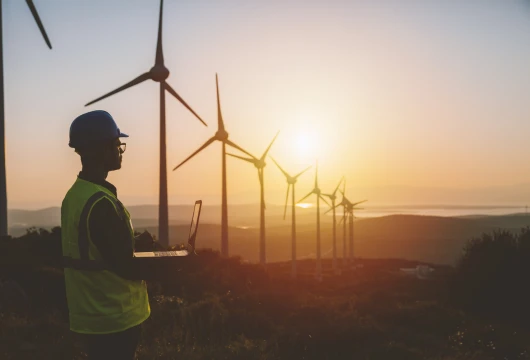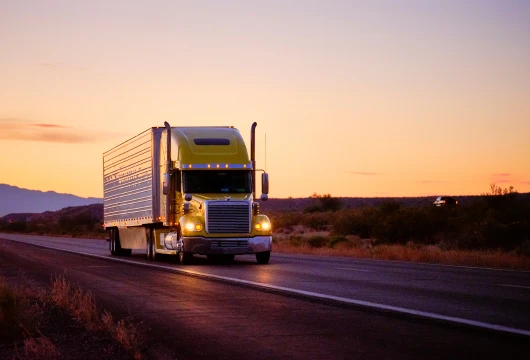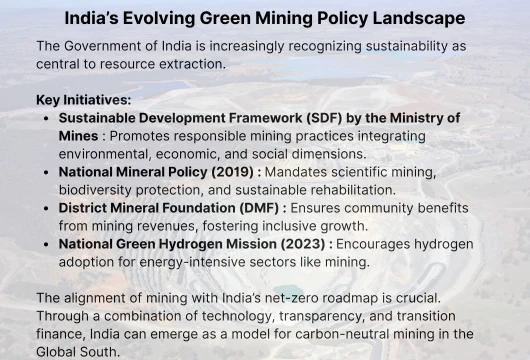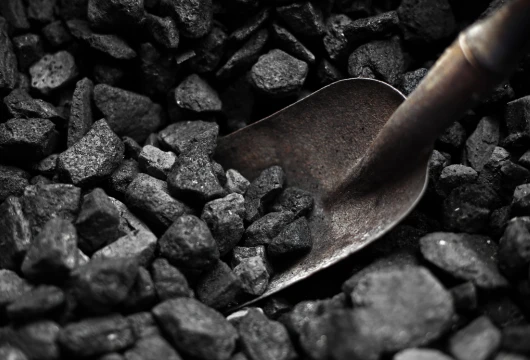A practical roadmap for India’s mining industry to achieve Carbon Neutral Mining operations through innovation, policy alignment, and sustainability leadership.
India’s mining industry has long been the backbone of its industrial and infrastructure growth. From coal and iron ore to bauxite and rare earth minerals, mining fuels power generation, steel production, construction, and even clean energy technologies themselves.
Yet, this sector is also one of the most carbon-intensive. According to the Ministry of Mines (GoI), India’s mining operations account for nearly 6–7% of total national greenhouse gas (GHG) emissions, driven by fossil-fuel-based energy, inefficient logistics, and lack of sustainable extraction technologies.
As India moves towards net-zero emissions by 2070, the pressure is mounting on heavy industries including mining to adopt cleaner, more efficient, and carbon-neutral practices. The challenge, however, lies in balancing economic dependence on mining with environmental responsibility.
The good news? With the right strategies, policies, and technological innovation, carbon-neutral mining is achievable. This article explores five key strategies India can adopt to move toward sustainable, low-carbon mining while staying globally competitive.
1️⃣ Transitioning to Renewable Energy Sources in Mining Operations

From Diesel to Decarbonization
The majority of India’s mines still depend heavily on diesel-powered machinery and coal-based electricity. Electrifying operations and integrating renewable energy are critical to decarbonizing the value chain.
Renewable Integration:
- Solar Microgrids & Wind Power: Many mines operate in remote, off-grid areas. Deploying solar microgrids or hybrid solar-wind systems can meet local energy needs sustainably.
- Green Hydrogen for Heavy Machinery: Hydrogen-based fuel cells are emerging as a cleaner alternative to diesel for large trucks and excavation equipment.
- Energy Storage: Battery storage and energy management systems can stabilize power supply during intermittency.
Global Example:
- BHP (Australia) has pledged to power its Chilean copper mines with 100% renewable energy by 2025, reducing 3 million tonnes of CO₂ annually.
India Example:
- Coal India Ltd. has announced plans to invest ₹5,650 crore in solar projects to meet 30% of its energy requirement from renewables by 2030.
Implementation Tip:
Create Renewable Energy Clusters near mining belts like Jharkhand, Odisha, and Chhattisgarh, supported by public-private partnerships and green energy wheeling policies.
2️⃣ Electrification and Automation of Mining Equipment
Smart Machines, Smaller Footprint
Heavy-duty vehicles, drills, and conveyors are among the most significant emitters in mining operations. Electrification and digital automation not only lower emissions but also improve safety and productivity.
Key Innovations:
- Electric Haul Trucks: Replacing diesel trucks with battery-electric or trolley-assist vehicles reduces direct emissions.
- Smart Drilling Systems: Digitally controlled drilling minimizes idle time, fuel waste, and dust.
- IoT and Predictive Maintenance: Internet of Things (IoT) sensors help optimize fuel use and detect equipment inefficiencies early.
- Remote Operations: Centralized, automated control centers reduce the need for on-site manpower, improving energy efficiency and operational oversight.

Global Example:
- Anglo American developed a 290-ton hydrogen-powered mining truck that can operate without diesel.
- Rio Tinto’s AutoHaul project in Australia uses fully autonomous trains to transport iron ore—reducing both emissions and human risk.
India Example:
- Hindustan Zinc, a Vedanta Group company, is piloting battery-electric mining equipment at its underground mines to phase out diesel machinery.
Implementation Tip:
Collaborate with technology firms to establish “Green Mining Innovation Hubs” under the Ministry of Mines for developing indigenous automation and electrification solutions.
3️⃣ Circular Economy and Waste Valorization

From Waste to Wealth
Mining produces vast amounts of waste—tailings, slag, and dust—that often go unused or cause environmental damage. A circular economy approach can transform waste into valuable resources, significantly reducing the sector’s carbon footprint.
Circular Practices Include:
Water Recycling: Closed-loop water management systems reduce water consumption and contamination.
Mine Waste Recycling: Tailings can be repurposed into construction materials such as cement additives or road aggregates.
Metal Recovery from Waste: Technologies like bioleaching and hydrometallurgy recover valuable minerals from low-grade ores and waste.
Re-mining Abandoned Sites: Recovering residual metals from old dumps prevents new extraction while reclaiming degraded land.
Global Example:
- Boliden (Sweden) reuses smelter dust and tailings to recover metals, reducing virgin extraction by 30%.
- Freeport-McMoRan (USA) recycles mining wastewater, cutting freshwater usage by 80%.
India Example:
- Tata Steel operates with a zero-waste mining policy, recycling over 90% of its solid waste.
- NALCO (National Aluminium Company) uses red mud for brick-making and road construction under its waste valorization initiative.
Implementation Tip:
Adopt mandatory Extended Producer Responsibility (EPR) frameworks within the mining industry to ensure companies reclaim and repurpose their waste streams.
4️⃣ Carbon Capture, Utilization, and Storage (CCUS) in Mining Processes
Capturing Emissions Before They Escape
While transitioning to renewables will take time, carbon capture and utilization (CCU) technologies offer an immediate pathway to mitigate emissions from ongoing fossil-based operations, especially in coal and metal refining.
Key Techniques:
- Post-Combustion Capture: Captures CO₂ from flue gases in thermal plants or smelters for reuse.
- Carbon Mineralization: Converts captured CO₂ into solid carbonates for construction material.
- Biochar Integration: Uses biochar (from biomass waste) in soil remediation at mined sites, sequestering carbon naturally.
- CO₂-to-Fuel Conversion: Emerging technologies can transform captured carbon into synthetic fuels.

Global Example:
- ExxonMobil’s LaBarge facility (USA) captures nearly 7 million tonnes of CO₂ annually.
- Glencore is testing CCUS at its metallurgical operations to neutralize Scope 1 emissions.
India Example:
- NTPC and Indian Oil Corporation have initiated pilot projects in CCUS for their power and refining units, offering potential models for the mining industry.
- The Central Mine Planning & Design Institute (CMPDI) is exploring coal mine methane (CMM) recovery, which reduces emissions while producing clean fuel.
Implementation Tip:
Create a National CCUS Roadmap for Mining, integrating policy support, fiscal incentives, and international collaboration to pilot carbon-neutral zones in mining districts.
5️⃣ ESG Integration and Data-Driven Sustainability Reporting

Transparency is the New Currency
The mining industry faces increasing scrutiny from investors, regulators, and communities on its Environmental, Social, and Governance (ESG) performance. Transparent, data-driven ESG reporting helps track progress toward carbon neutrality and enhances credibility.
Strategic Steps:
- Measure & Monitor Emissions: Use IoT-enabled carbon accounting systems to measure Scope 1, 2, and 3 emissions across supply chains.
- Adopt International Standards: Align with frameworks like Global Reporting Initiative (GRI), Task Force on Climate-Related Financial Disclosures (TCFD), and SASB Mining Standards.
- Digital Twins: Use simulation models to predict environmental outcomes and optimize sustainability decisions.
- Community Engagement: Build trust by publishing sustainability dashboards and progress updates.
Global Example:
- Newmont Corporation publishes a climate report aligned with TCFD, linking executive pay with emissions reduction targets.
India Example:
- NMDC Limited integrates sustainability metrics into its annual reports and has committed to carbon neutrality by 2040.
- Vedanta Resources uses AI-based sustainability dashboards to monitor its ESG metrics across global operations.
Implementation Tip:
Establish a National ESG Benchmarking Index for Mining under SEBI to encourage uniform sustainability reporting across the sector.

Challenges to Achieving Carbon-Neutral Mining
Despite growing awareness, the journey to carbon-neutral mining faces hurdles:
- High Capital Expenditure: Transitioning to electric fleets or renewables demands significant upfront investment.
- Technology Gaps: Limited domestic manufacturing for green mining technologies.
- Skill Shortages: Workforce needs retraining in automation, data analytics, and renewable integration.
- Policy Inconsistency: Frequent regulatory changes can deter long-term investments.
- Lack of Carbon Pricing Mechanism: Without a clear carbon market, incentives remain weak.
Solution Pathways:
- Offer green tax credits and low-interest loans for sustainable mining projects.
- Encourage academic-industry partnerships to develop indigenous green mining tech.
- Include sustainability modules in mining engineering education.
Global Lessons India Can Learn
- 1. Australia: Technology-Driven Sustainability
- Australia’s “METS” (Mining Equipment, Technology, and Services) ecosystem demonstrates how tech innovation can cut emissions by up to 30%.
- 2. Chile: Renewable-Powered Copper Mining
- Chile uses 80% renewable energy for its copper mines, setting a benchmark for energy diversification.
- 3. Norway: Electric Mines
- Norway’s Rana Gruber iron ore mine runs almost entirely on hydroelectric power and battery-electric trucks.
- 4. Canada: Community-First Mining
- Canada integrates Indigenous communities into mining governance, ensuring equitable, sustainable growth.These examples underline that carbon-neutral mining isn’t an isolated goal—it’s a systemic transformation involving collaboration across policy, technology, and society.
These examples underline that carbon-neutral mining isn’t an isolated goal—it’s a systemic transformation involving collaboration across policy, technology, and society.
Economic Upside of Carbon-Neutral Mining in India
- Attracts ESG Investment: Global funds now prioritize low-carbon portfolios; sustainable mines can access cheaper capital.
- Enhances Export Competitiveness: With the EU’s Carbon Border Adjustment Mechanism (CBAM), carbon-intensive exports will face tariffs—clean mining can protect India’s trade edge.
- Creates Jobs in Green Tech: The shift to electrified, digital mining opens new roles in automation, data science, and renewable infrastructure.
- Boosts Brand Reputation: Sustainability leadership improves stakeholder trust and long-term valuation
According to TERI estimates, green mining could add $20–25 billion to India’s GDP by 2035 while aligning with national climate targets.
The Road Ahead — Greening the Mines, Empowering the Future
India stands at a defining crossroads. The path of carbon-neutral mining is not easy, but it is necessary—and achievable. By aligning innovation with inclusivity, technology with transparency, and growth with green goals, India can lead the next frontier of responsible resource extraction.
Mining fuels development—but how we mine will determine our destiny. A greener, carbon-neutral approach ensures that India’s resource wealth doesn’t come at the cost of environmental degradation or community well-being.
It’s time for the industry, policymakers, and innovators to dig deeper—not for more minerals, but for more sustainable solutions.
Because the future of mining isn’t beneath the earth—it’s in our collective commitment to the planet.
For more inspiring Blogs, click here

